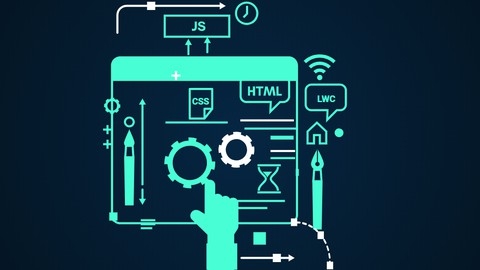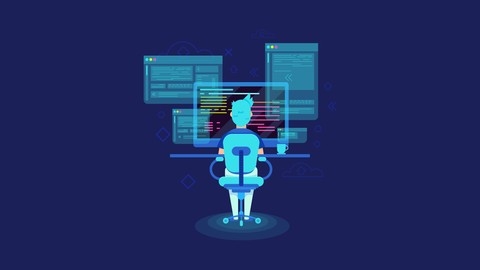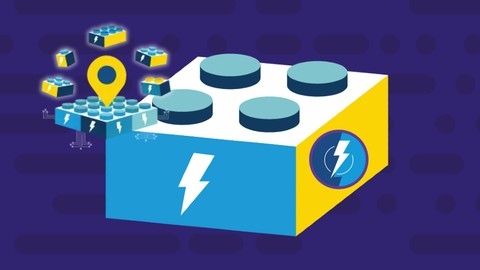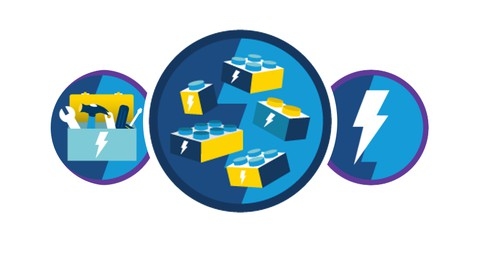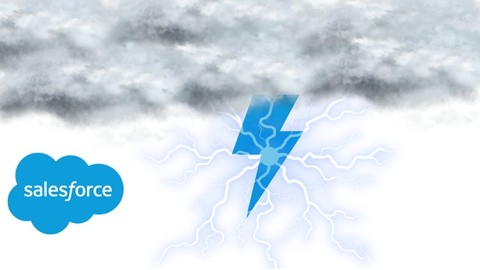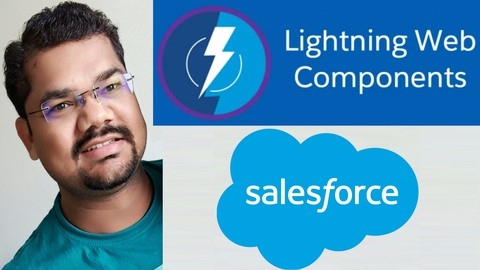Lightning Web Components (LWC) are a powerful and modern way to build dynamic and interactive user interfaces within Salesforce.
They allow developers to create custom components that seamlessly integrate with Salesforce’s platform, enhancing the user experience and streamlining business processes.
Learning LWC opens up opportunities to build engaging applications, automate workflows, and take your Salesforce development skills to the next level.
Finding the right LWC course on Udemy can be a challenge with so many options available.
You’re looking for a course that is comprehensive, engaging, and taught by experts who can guide you through the complexities of LWC development.
You want a course that goes beyond theory, providing hands-on experience and real-world projects to solidify your understanding.
We’ve reviewed countless courses and based on our analysis, Zero to Hero in Lightning Web Components is the best course on Udemy overall.
This course provides a comprehensive and practical approach to LWC development, starting with the fundamentals and building up to advanced concepts.
It features real-world projects, engaging video lessons, and a strong emphasis on hands-on learning.
While this is our top pick, there are other excellent options available.
Keep reading to explore our recommendations for different learning styles and goals, from beginner-friendly introductions to advanced courses focused on specific LWC techniques and real-world use cases.
Zero to Hero in Lightning Web Components
You’ll start by mastering the fundamentals of HTML, CSS, and JavaScript, providing a solid base for your LWC development.
The course dives deep into the intricacies of LWC architecture, showing you how to structure your components, implement data binding, and leverage properties and methods for dynamic interactions.
You’ll also learn how to style your components using Lightning Design System (SLDS), ensuring visually appealing and consistent user experiences.
A key strength of this course lies in its practical approach.
You’ll gain hands-on experience through projects like building a quiz app, a memory game, and a books listing app with a REST API callout.
These projects allow you to apply your knowledge and solidify your understanding of LWC concepts.
Beyond the basics, the course delves into advanced topics like component communication, data access using the Lightning Data Service, and incorporating real-time features.
You’ll also explore techniques for PDF generation, charting, and navigating between different Salesforce pages and records using the Navigation Service.
This course provides a solid foundation for building robust and scalable LWCs, equipping you with the skills to create engaging and effective user experiences within the Salesforce platform.
The Ultimate Hands-On Lightning Web Component
This course provides a robust foundation in Lightning Web Components (LWC), equipping you with the skills to build dynamic and interactive user interfaces within Salesforce.
You’ll start by solidifying your JavaScript fundamentals, exploring concepts like variables, data types, functions, loops, and object-oriented programming (OOP).
This forms the bedrock for understanding how LWC components seamlessly interact with Salesforce data.
The course then dives into the heart of LWC, guiding you through setting up your development environment, crafting your first component, implementing data binding, and applying CSS styling.
The emphasis on practical learning shines through with engaging projects, including a simple calculator and a more complex car rental application.
You’ll learn to leverage Lightning Data Service (LDS), a powerful tool for accessing and manipulating Salesforce data within your LWC components.
Moving beyond the basics, you’ll delve into advanced topics like component communication, handling events effectively, and utilizing the Lightning Navigation Service.
You’ll gain the confidence to integrate third-party libraries and rigorously test your LWC components using the JTest framework.
The course also covers Salesforce’s Lightning Design System (SLDS), enabling you to create visually appealing and consistent interfaces.
You’ll explore cutting-edge LWC features like Lightning Messaging Service for seamless communication between components, CSS modules for shared styles, and the ‘isConnected’ property for checking component connectivity.
Lightning Web Component Development
You’ll begin by solidifying your understanding of JavaScript fundamentals, covering key concepts like variables, functions, and loops, which form the bedrock of any web application.
The course then delves into the world of Lightning Web Components (LWC), guiding you through the process of building interactive components that seamlessly integrate with Salesforce.
You’ll gain a deep understanding of the LWC lifecycle, master techniques for communication between components using events, and learn how to efficiently access and manipulate Salesforce data using LDS and the UI Record API.
The curriculum also dives into advanced topics like testing LWCs with Jest, building complex components such as data tables and modals, and leveraging the latest Salesforce features like GraphQL.
Throughout the course, you’ll be actively engaged through hands-on exercises and practical labs, providing ample opportunity to apply what you’ve learned.
You’ll become proficient in using tools like Visual Studio Code and the Salesforce CLI to manage your code and deploy it to Salesforce.
This course is a valuable resource for individuals looking to develop a solid foundation in building Lightning Web Components, and it will empower you to create engaging and efficient user experiences within the Salesforce ecosystem.
Salesforce Lightning Web Component Development
You’ll start by setting up your development environment, learning how to leverage the Salesforce CLI and Visual Studio Code for efficient development.
Building your first Lightning Web Components, you’ll delve into essential concepts like data binding, conditional rendering, and iterating through lists of items.
The course then guides you through building simple applications, like an interest calculator, showcasing how Lightning Web Components can bring interactivity to your Salesforce platform.
You’ll explore different types of properties and learn how to effectively pass data between components, creating interactive and responsive applications.
The course also introduces you to the powerful Lightning Data Service, enabling you to directly interact with Salesforce data from your Lightning Web Components.
You’ll learn how to create, view, and update records, unlocking a new level of data management within your LWC applications.
To further enhance your development skills, you’ll delve into Apex, a powerful programming language that allows you to fetch data from Salesforce, adding another layer of functionality to your LWC projects.
The course doesn’t stop at functionality; it also teaches you how to create engaging user experiences through toast notifications and the Navigation Service.
These tools allow you to provide clear feedback to users and seamlessly navigate them through different areas of Salesforce, ensuring a smooth and intuitive experience.
Testing is an essential part of any development process, and this course covers using the Jest framework, ensuring your LWC code functions as intended.
Finally, you’ll cap off the course by building a real-world application – the Ebike Explorer.
This project demonstrates how to utilize REST API callouts to fetch data from external sources and seamlessly integrate it into your LWC applications, expanding the capabilities of your Salesforce projects.
Salesforce Lightning web component with live project
You’ll start with the fundamentals, exploring the relationship between LWC, Aura components, and Visualforce, and understanding why LWC is the preferred choice for modern Salesforce development.
You’ll then delve into setting up your development environment using tools like Visual Studio Code, Salesforce Extension Pack, and Salesforce CLI.
The course meticulously covers core LWC concepts like HTML templates, JavaScript, and configuration files, showing you how to expose your components in Lightning Record Pages and style them using both Custom CSS and the Salesforce Lightning Design System (SLDS).
As you progress, the course dives into advanced LWC features like managing data using JavaScript properties, conditional rendering, and iteration.
You’ll learn about LWC lifecycle hooks and gain valuable insights into accessing custom labels, static resources, and user information.
The course provides detailed guidance on utilizing the Salesforce Navigation Service to navigate between pages and on interacting with Apex classes and methods through Wire services.
This includes invoking Apex methods imperatively and leveraging the power of Lightning Data Services to access Salesforce data.
A key highlight of this course is the real-world “Search My Home” project.
This project will put your LWC knowledge into practice as you build components for searching properties, displaying property details, and handling property inquiries.
You’ll learn how to communicate between components using custom events and the Lightning Message Service, gaining hands-on experience with features like pagination, data tables, and modals.
The course concludes with a thorough overview of the project and its source code, ensuring you’re equipped to build robust LWC applications.
This course is particularly strong in its clear explanations and practical approach.
The instructor’s expertise is evident in the way they break down complex concepts into digestible steps, making LWC development accessible for beginners.
The real-world project provides valuable hands-on experience, solidifying your understanding and preparing you for real-world Salesforce development.
Salesforce Lightning Web Components
This comprehensive course will equip you with the skills to build dynamic and interactive user interfaces using Lightning Web Components (LWC).
You’ll start by diving into the fundamentals of LWC development, learning the building blocks of components and mastering core concepts like data binding and HTML rendering.
The course goes beyond the basics, guiding you through the process of interacting with Salesforce data.
You’ll learn to leverage the power of the lightning-record-view-form to display record details and use the getRecordFieldValues API to retrieve specific field values.
You’ll also master the creation, update, and deletion of records using the createRecord, updateRecord, and deleteRecord APIs.
You’ll delve into advanced LWC development, exploring techniques like calling Apex methods from your components and saving records using Apex.
This course goes beyond simple data interaction, providing you with the knowledge to efficiently add and delete rows in a lightning-datatable and create a Custom Lookup component.
The course focuses on building a robust understanding of communication between LWC components.
You’ll explore parent-child communication and master the use of the Lightning Message Service for communication between LWC, Aura components, and Visualforce pages.
You’ll also learn how to dynamically populate data using properties, expose your components in Quick Actions, and subscribe to platform events.
Finally, you’ll explore the integration of LWC into flows, empowering you to automate complex business processes with LWC components.
This course provides a solid foundation for building sophisticated LWC applications that enhance the user experience and streamline your business workflows.
Salesforce Lightning Web Components: Zero to Hero
You’ll start by understanding the structure of a component bundle and delving into the intricacies of managing variables and arrays.
The course then guides you through building visually appealing components with CSS, emphasizing the use of PublicVars for effective styling.
You’ll quickly dive into the powerful world of data manipulation with Lightning Data Service, learning to seamlessly connect your LWCs to Salesforce data.
The course expertly explores the Wire Service, empowering you to retrieve data directly into your components with ease.
You’ll then gain mastery over the Service Side Controller (SSC), acquiring a deeper level of control over your data access.
The curriculum equips you to build interactive components by leveraging the power of events and lifecycle hooks.
You’ll learn about sharing data effectively between components using the Pub/Sub pattern, ensuring a robust and efficient workflow.
The course also covers essential migration techniques, allowing you to seamlessly move your LWCs between Salesforce environments.
The final section focuses on unit testing with Jest, a vital tool for ensuring the quality and reliability of your LWCs.
Salesforce LWC (Lightning Web Component) with Live Project
You’ll start by setting up your development environment, learning to write Apex Code in Visual Studio Code.
This foundation lays the groundwork for creating your first LWC, deploying it to your Salesforce org, and even deleting it to start fresh – a crucial skill for any developer.
The course then dives into the heart of LWC development, covering data binding, conditional rendering, and various loop constructs.
You’ll master decorators like @api, @track, and @wire, essential for interacting with Apex classes and Salesforce data.
The focus on these core concepts provides a solid understanding of how LWCs function within the Salesforce ecosystem.
Next, you’ll build Lightning App Pages, the foundation of your LWC-powered Salesforce experience.
The course explores message passing, enabling complex interactions between components, and introduces the Lightning Message Service for even more robust data communication between unrelated components.
A real-time project takes you through the challenges of building a complete LWC application.
This hands-on experience solidifies your learning, covering aspects like building a Lightning Data Table, using the @wire decorator to call Apex methods, and managing data flow with the Lightning Message Service.
The course then takes you beyond standard Salesforce development, exploring integration with external APIs like IMDb using tools like Postman and named credentials.
Finally, you’ll delve into the exciting possibilities of integrating ChatGPT into your Salesforce development process.
This cutting-edge approach opens up new avenues for AI-powered development, a valuable skill in the evolving landscape of Salesforce development.
